Abstract
Metabolic tolerance to a 'premature formula' feed was studied in a group of small immature infants, mean (SD) gestation 27.8 (1.4) weeks. Ten infants weighing 880-1295 g at the time of the study were fed on SMA low birthweight formula for a mean (SD) of 23.5 (5.5) days and were compared with 10 who were fed on expressed breast milk for 25.8 (6.1) days. The infants were well matched for weight, gestation, and postnatal age at the time of the study and were receiving full enteral feeds. They were investigated by balance techniques and plasma sampling on at least two occasions. Ten larger infants weighing 1330-1740 g and being fed on the same formula feed were also studied as an additional control group. Formula fed infants retained more nitrogen and gained weight faster. Plasma phosphorus concentrations were higher in the group fed on the formula feed, and alkaline phosphatase activity was lower. There were no significant differences in plasma concentrations of urea, electrolytes, or albumin or in acid base status. Taurine and arginine concentrations were higher in the group being breast fed, but there were no other significant differences in plasma amino acids, and no toxic concentrations occurred after either feed. The results of this study show that this formula (and presumably other feeds of similar composition) seem to be metabolically safe for the smallest infants.
Full text
PDF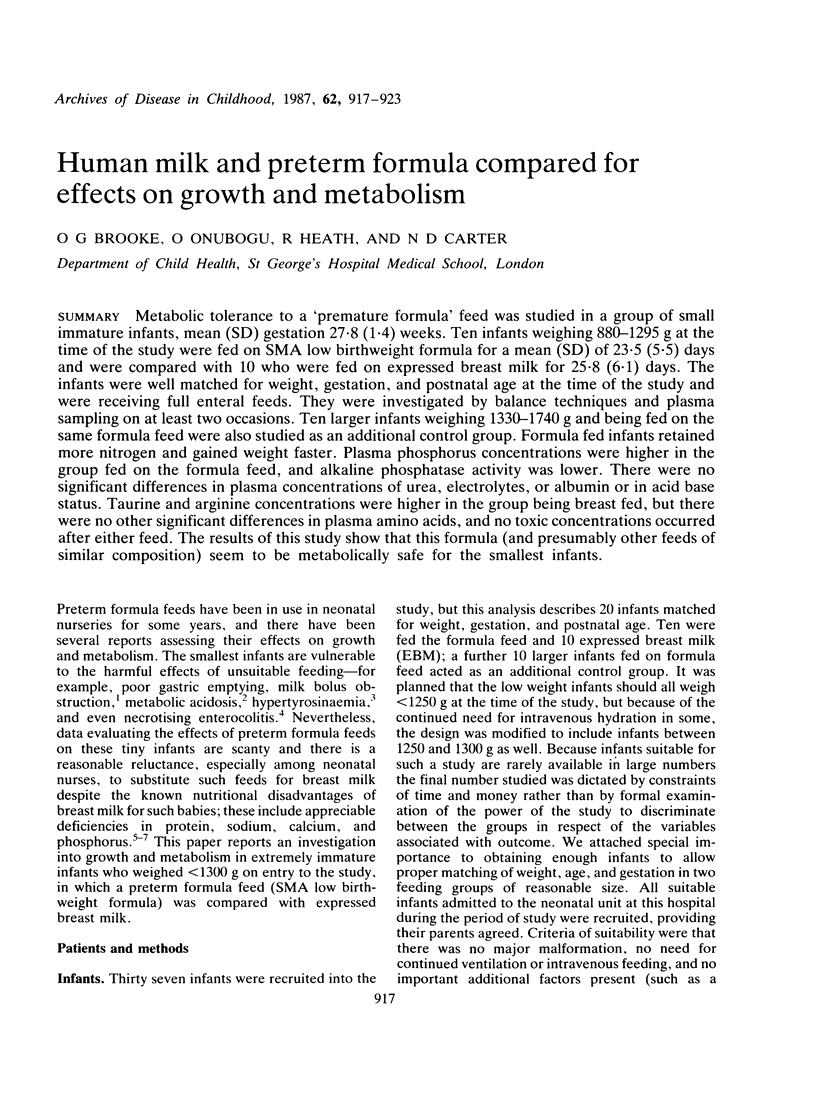

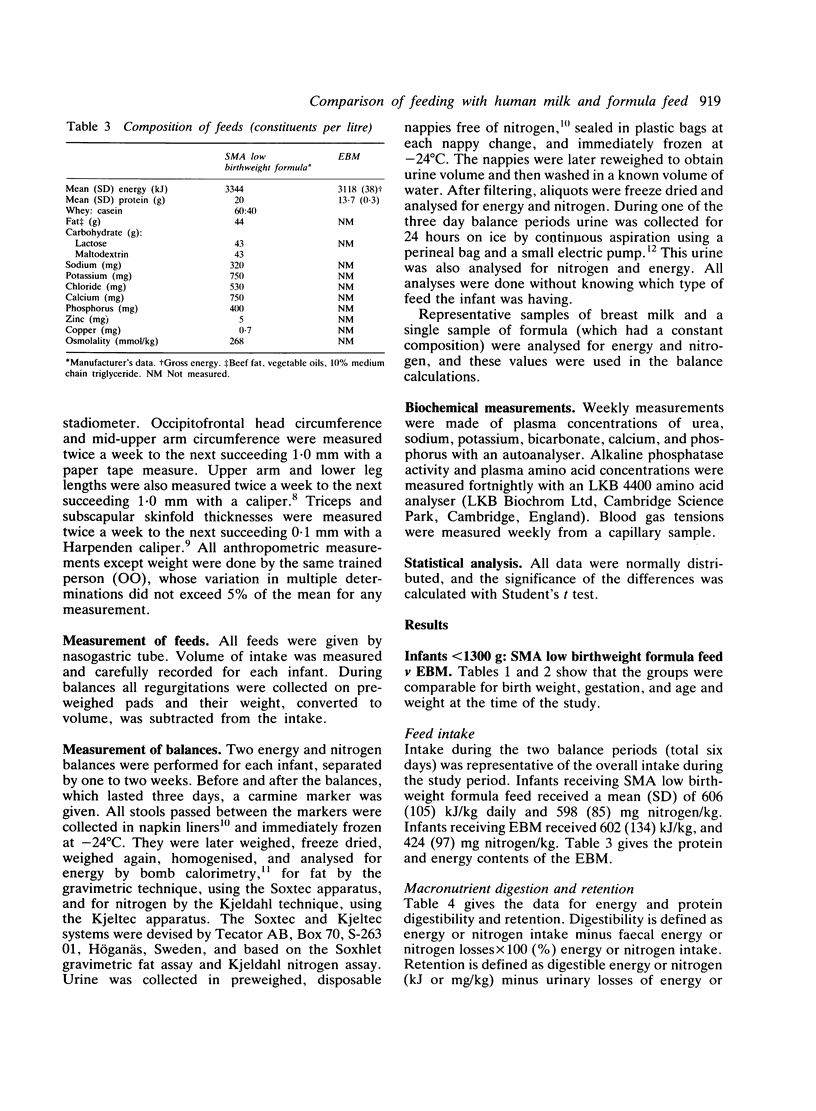
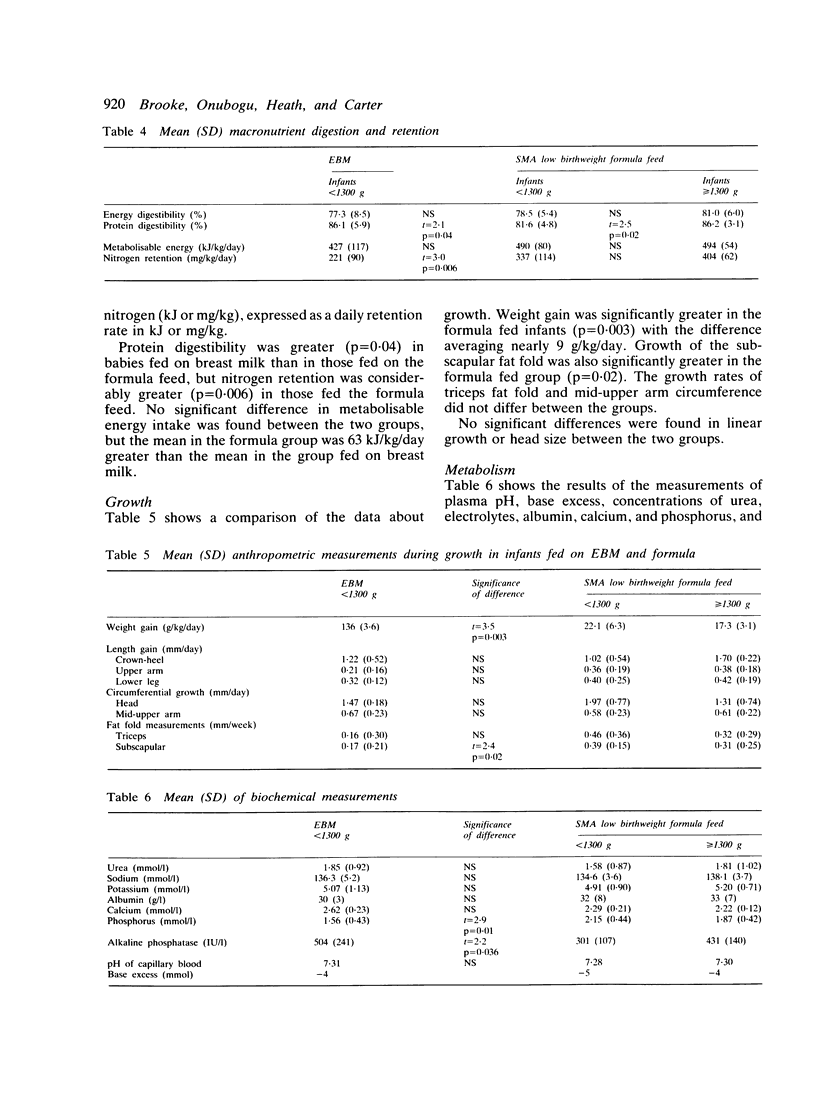

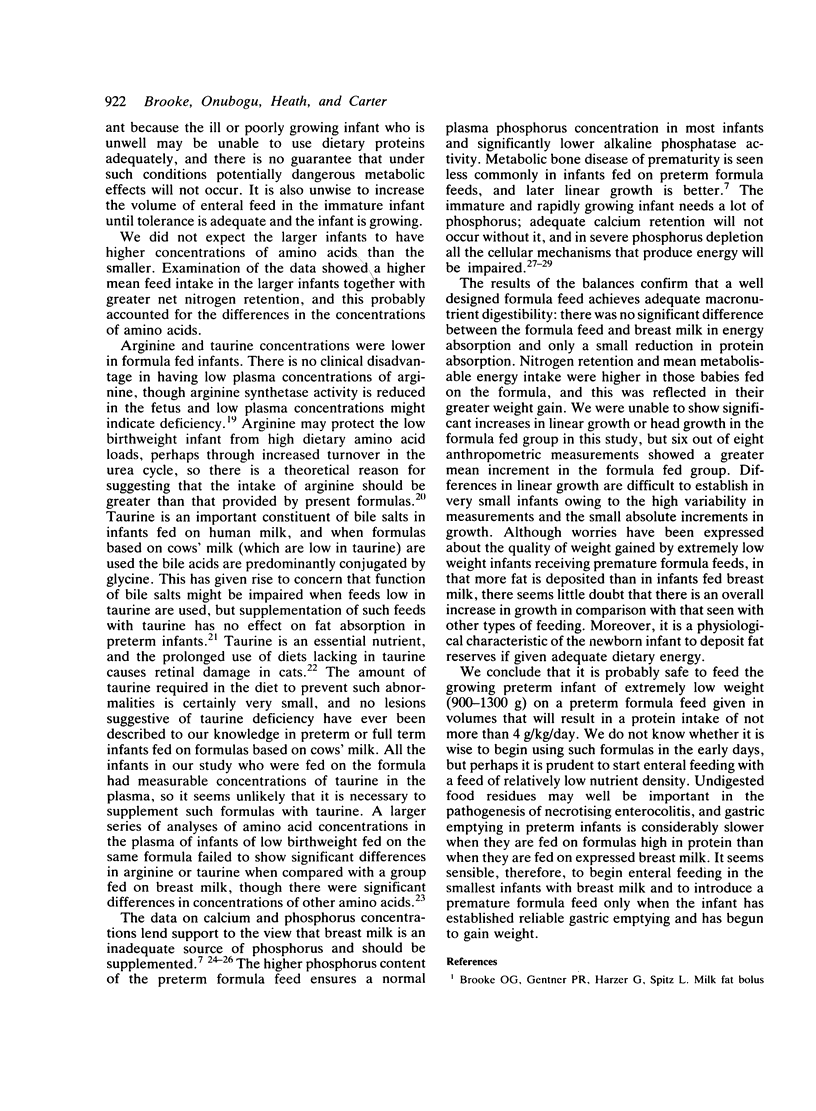
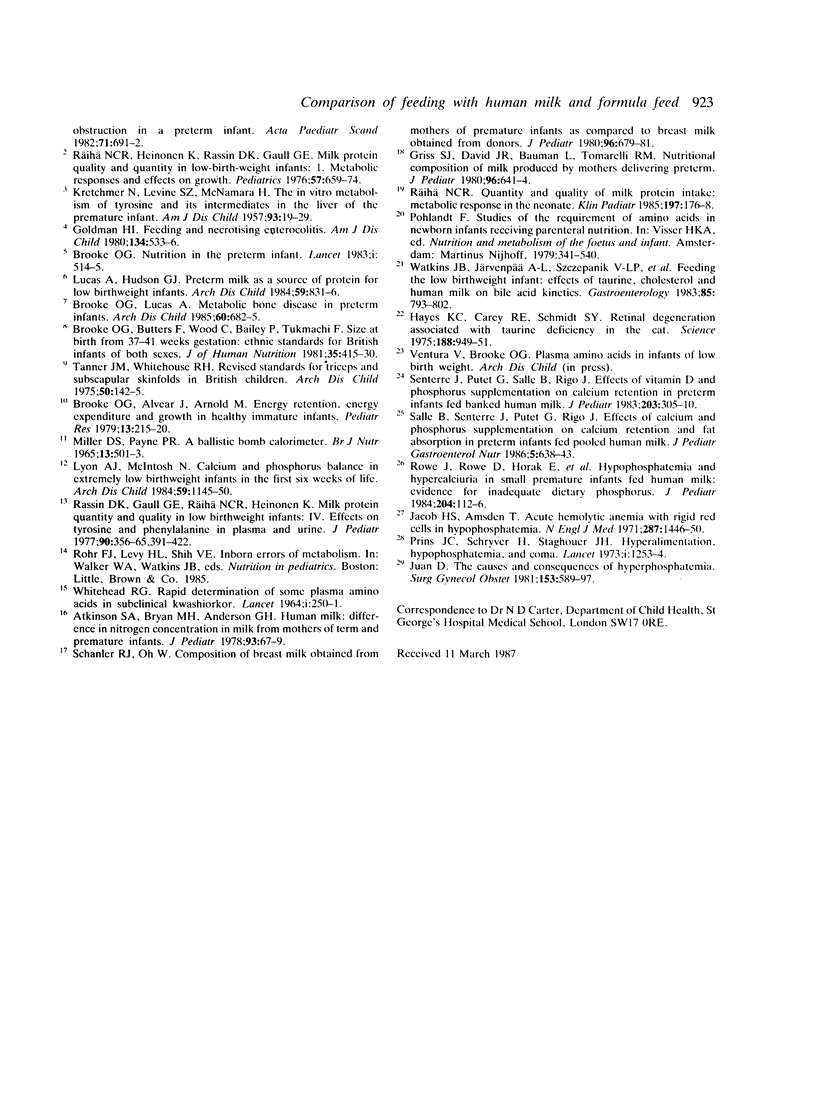
Selected References
These references are in PubMed. This may not be the complete list of references from this article.
- Atkinson S. A., Bryan M. H., Anderson G. H. Human milk: difference in nitrogen concentration in milk from mothers of term and premature infants. J Pediatr. 1978 Jul;93(1):67–69. doi: 10.1016/s0022-3476(78)80602-7. [DOI] [PubMed] [Google Scholar]
- Brooke O. G., Alvear J., Arnold M. Energy retention, energy expenditure, and growth in healthy immature infants. Pediatr Res. 1979 Apr;13(4 Pt 1):215–220. doi: 10.1203/00006450-197904000-00001. [DOI] [PubMed] [Google Scholar]
- Brooke O. G., Butters F., Wood C., Bailey P., Tukmachi F. Size at birth from 37 - 41 weeks gestation: ethnic standards for British infants of both sexes. J Hum Nutr. 1981 Dec;35(6):415–430. [PubMed] [Google Scholar]
- Brooke O. G., Lucas A. Metabolic bone disease in preterm infants. Arch Dis Child. 1985 Jul;60(7):682–685. doi: 10.1136/adc.60.7.682. [DOI] [PMC free article] [PubMed] [Google Scholar]
- Hayes K. C., Carey R. E., Schmidt S. Y. Retinal degeneration associated with taurine deficiency in the cat. Science. 1975 May 30;188(4191):949–951. doi: 10.1126/science.1138364. [DOI] [PubMed] [Google Scholar]
- Jacob H. S., Amsden T. Acute hemolytic anemia with rigid red cells in hypophosphatemia. N Engl J Med. 1971 Dec 23;285(26):1446–1450. doi: 10.1056/NEJM197112232852602. [DOI] [PubMed] [Google Scholar]
- Juan D. The causes and consequences of hypophosphatemia. Surg Gynecol Obstet. 1981 Oct;153(4):589–597. [PubMed] [Google Scholar]
- Lucas A., Hudson G. J. Preterm milk as a source of protein for low birthweight infants. Arch Dis Child. 1984 Sep;59(9):831–836. doi: 10.1136/adc.59.9.831. [DOI] [PMC free article] [PubMed] [Google Scholar]
- Lyon A. J., McIntosh N. Calcium and phosphorus balance in extremely low birthweight infants in the first six weeks of life. Arch Dis Child. 1984 Dec;59(12):1145–1150. doi: 10.1136/adc.59.12.1145. [DOI] [PMC free article] [PubMed] [Google Scholar]
- MILLER D. S., PAYNE P. R. A ballistic bomb calorimeter. Br J Nutr. 1959;13:501–508. doi: 10.1079/bjn19590064. [DOI] [PubMed] [Google Scholar]
- Prins J. G., Schrijver H., Staghouwer J. H. Hyperalimentation, hypophosphataemia, and coma. Lancet. 1973 Jun 2;1(7814):1253–1254. doi: 10.1016/s0140-6736(73)90570-9. [DOI] [PubMed] [Google Scholar]
- Rassin D. K., Gaull G. E., Räihä N. C., Heinonen K. Milk protein quantity and quality in low-birth-weight infants. IV. Effects on tyrosine and phenylalanine in plasma and urine. J Pediatr. 1977 Mar;90(3):356–360. doi: 10.1016/s0022-3476(77)80693-8. [DOI] [PubMed] [Google Scholar]
- Rowe J., Rowe D., Horak E., Spackman T., Saltzman R., Robinson S., Philipps A., Raye J. Hypophosphatemia and hypercalciuria in small premature infants fed human milk: evidence for inadequate dietary phosphorus. J Pediatr. 1984 Jan;104(1):112–117. doi: 10.1016/s0022-3476(84)80606-x. [DOI] [PubMed] [Google Scholar]
- Räihä N. C., Heinonen K., Rassin D. K., Gaull G. E. Milk protein quantity and quality in low-birthweight infants: I. Metabolic responses and effects on growth. Pediatrics. 1976 May;57(5):659–684. [PubMed] [Google Scholar]
- Räihä N. Quantity and quality of milk protein intake: metabolic responses in the neonate. Klin Padiatr. 1985 Mar-Apr;197(2):176–178. doi: 10.1055/s-2008-1033963. [DOI] [PubMed] [Google Scholar]
- Salle B., Senterre J., Putet G., Rigo J. Effects of calcium and phosphorus supplementation on calcium retention and fat absorption in preterm infants fed pooled human milk. J Pediatr Gastroenterol Nutr. 1986 Jul-Aug;5(4):638–642. doi: 10.1097/00005176-198607000-00022. [DOI] [PubMed] [Google Scholar]
- Tanner J. M., Whitehouse R. H. Revised standards for triceps and subscapular skinfolds in British children. Arch Dis Child. 1975 Feb;50(2):142–145. doi: 10.1136/adc.50.2.142. [DOI] [PMC free article] [PubMed] [Google Scholar]
- WHITEHEAD R. G. RAPID DETERMINATION OF SOME PLASMA AMINOACIDS IN SUBCLINICAL KWASHIORKOR. Lancet. 1964 Feb 1;1(7327):250–252. doi: 10.1016/s0140-6736(64)92353-0. [DOI] [PubMed] [Google Scholar]


